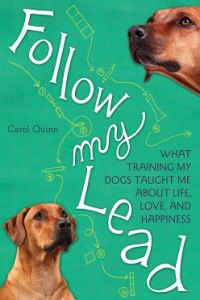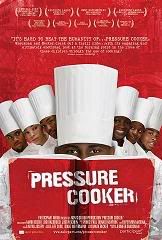 Carol Quinn is the author of Follow My Lead: What Training My Dogs Taught Me about Life, Love, and Happiness. A strategic advisor at her company ProjectQuinn, she is also an adjunct faculty member at USC Annenberg School for Communications and Journalism.
Carol Quinn is the author of Follow My Lead: What Training My Dogs Taught Me about Life, Love, and Happiness. A strategic advisor at her company ProjectQuinn, she is also an adjunct faculty member at USC Annenberg School for Communications and Journalism.
Quinn talks about how she got published, writing from personal experience, and more in this Write On! Q&A.
Why did you write Follow My Lead?
So many of us have close relationships with our dogs, and we rely on them for love and companionship. For me, the experience of training my dogs in agility brought a deeper understanding of the nature of dogs, and it led me to look at my life in a different way. From a dog’s point of view, I was doing everything all wrong.
I’ve always been interested in the fundamentals of personal transformation; what are the right conditions for change, what are the necessary ingredients? It became clear to me during my agility classes that my relationship with life—and the man in my life—were both in need of a radical adjustment. Applying the training I was learning from my agility teacher to my own life worked to bring about that transformation for me. And my dogs, Nairobi and Sheila, became my guides in the process.
When I looked back over the experiences I’d been through, I thought the story about learning from my dogs might appeal to readers, and be something many people could relate to. The book evolved from there.
What was your process for writing it? Getting it published?
I got the idea for the book, wrote a proposal, worked with an editor whom I’ve collaborated with for years to get things just right, and sent it to my agent. He called two days later, made a few suggestions, and then he started sending out the proposal to publishers. Of course, I got a few rejections. That’s never a good feeling. I was in NYC with my best friend when I got a call from the editor at Seal Press. She loved the proposal, I was thrilled, and that was that.
For the proposal, I had already completed five chapters and an outline. When I began writing the book, I rewrote and extended the material quite a bit. Structuring material for a book proposal is far different from writing a book. Proposals are really short sales pieces.
I finished the manuscript in three months, turned in my first draft, and then began working with my editor at Seal Press, Merrik Bush-Pirkle. The first draft, for me, is an indication of the final material. Everything I want is in the manuscript, but it’s in need of rearrangement and finesse. I have never written a perfect first draft, and I don’t even try. There’s still a missing voice in the process—the editor. Once you get a chance to learn how your editor “hears” your writing, it’s really the first time you get feedback on what you’re trying to create. Merrik and I spent another three months working chapter by chapter, incorporating her notes into my rewrites before I turned in my final draft.
When writing from real life, how did you decide what to include and what to eliminate?
My main concern was protecting the people in my life while telling the truth about my experiences. This is, after all, my story, and I had to tell it from my point of view. I tried to give enough detail for the reader to understand the characters in my book, particularly Henry and Irina, but I focused on their effect on me. I did not focus on why they did what they did. That’s their story.
It’s a tricky process, though, I have to admit. I trusted my editor implicitly throughout. If something I wrote made her uncomfortable, I deleted it. If she didn’t grasp an emotional flow in a scene, I rewrote until she did.
What was the most your favorite part of writing it? The greatest challenge?
I love writing so much it’s hard for me to pinpoint my favorite part of the process. Beginnings are wonderful because you aren’t hampered by anyone’s opinion. The editing process is exciting because you get the chance to clarify and improve your writing. Ending the book is glorious.
The greatest challenge for me was “track changes.” I like reading editorial notes on a printed manuscript. It’s very hard to do it onscreen—and frustrating.
Advice for dog lovers who want to write?
There are wonderful dog books out there. It’s a great category, and I would encourage anyone who thinks that they have a great story—tell it! Blogs to books are a great way to go, and there is a great community of pet bloggers on http://www.blogpaws.com/
Advice for non-fiction writers?
This was my first non-fiction/memoir, and I would have to say the mechanics of structuring a good story are the same. Finding the dramatic arc, though, takes a bit of work. Life doesn’t always present you with the right beginning, middle and end. I ended up going back and forth in time to create the narrative.
For anyone writing a memoir, it’s important to create a distance between your emotional experience and the story you want to tell. Not every aspect of your emotional experience may translate into a narrative form or resonate with readers.
What do you know now that you wish you knew when you started writing Follow My Lead?
I’m not sure I would have wanted to know this beforehand, but it’s very hard to get people’s attention these days. Everyone is swamped, busy with their own projects and fielding requests left and right. And the social media and traditional media clutter is intense. It takes a lot effort to entice someone to sit down and read a book, let alone write an Amazon review!
That said, it’s a lot of fun to make connections with readers and reviewers whenever—and wherever I can. And it’s an amazing feeling when someone has been touched by the book. For me, that’s the whole point of writing.
Tags: Author Q&A Carol Quinn Dogs Follow My Lead Memoir Non-fiction Write On! Online









